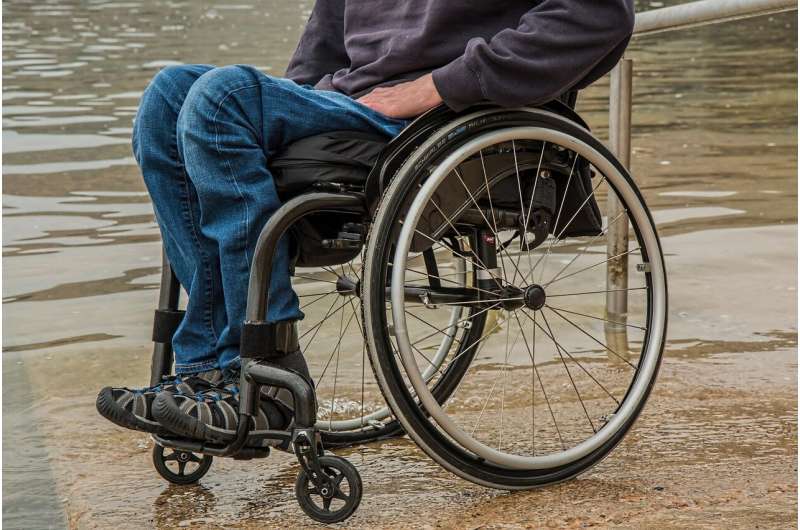Studies show number of US medical students with disabilities grows, but disparities continue

Johns Hopkins Medicine researchers report that the number of disabled students admitted to U.S. medical schools rose from 2.9% to 4.9% over the last three years. However, the percentage of NIH-funded researchers with disabilities declined between 2008 and 2018. The grant success rate for this group was lower than for researchers without a disability, indicating that despite more people with disabilities prepared to enter biomedical research, their prospects as professionals are weakening.
The findings, published Nov. 26 in the Journal of the American Medical Association and March 3 in PLOS, highlight the need for more intense efforts to remove barriers to training, employment and research support for people with disabilities.
"There is a lot of value to including people with disabilities in medicine—taking care of patients with the same experience is a nuanced perspective that I think is greatly overlooked," says Bonnielin Swenor, Ph.D., M.P.H., professor of ophthalmology at the Johns Hopkins University School of Medicine and a member of its Wilmer Eye Institute. "We need to do more to understand the barriers keeping people with disabilities from opportunities and identify the specific unmet needs in the workforce." Swenor herself has vision impairment.
The first study, published Nov. 26, evaluated 56,217 responses to a survey at 87 U.S. allopathic medical schools. Some 2,600 (4.9%) students self-reported having at least one of eight disabilities identified in the survey. This is an increase from 2.9% of medical students reporting disability in a 2016 baseline report.
"The good news is that the number of medical students admitted with disabilities is growing, but their path after they finish their training is far from clear," says Swenor.
A follow-up study, published March 3 in PLOS, found that instead of increasing with a burgeoning number of trainees, federal funding for researchers with disabilities decreased between 2008 and 2018 by almost 1%. Additionally, researchers with disabilities were less likely to receive grant funding compared with those without a disability, signaling a potential bias for those with disabilities in the grant review process. The researchers determined this by analyzing the data of NIH grant applicants and awardees recorded each fiscal year within the eRACommons portal. This is in contrast to grants awarded to researchers not reporting a disability, which increased from 86.6% in 2008 to 89.7% in 2018.
Though the data cannot address the reasoning behind the drop in funding to researchers with disabilities, Swenor says there are three potential scenarios: First, there could be fewer people with disabilities entering research than before. Second, researchers with disabilities are submitting fewer applications than researchers without disabilities. Or third, more researchers with disabilities are withholding their disability status because their disability is not listed in the application or they are fearful of discrimination against their disability status.
According to the CDC, about 26% of Americans have a disability. However, the researchers say only about 10% of employed scientists report a disability. "To reflect the realities of our society, we should have far more people with disabilities working in research and medicine," says Swenor.
"Federal funding agencies like the NIH have made clear commitments to increasing diversity in research. However, this data shows that there is still a lot of work to be done, especially for researchers with disabilities," says Swenor.
Swenor found this trend extends to the general workforce in a third study, published Dec. 5 in JAMA Opthalmology. Her research team found that people with vision or hearing disabilities had higher unemployment rates than groups without a disability, 33.3% and 24.9% respectively. However, those with both a visual and hearing impairment had the highest rates of unemployment of any group, with a 61% unemployment rate.
"These groups often fall through the cracks when it comes to getting accommodations and are more vulnerable to discriminatory unemployment," says Swenor.
The Americans with Disabilities Act was passed in 1990 to provide people with disabilities employment opportunities and benefits equal to those provided people without a disability. However, Swenor suggests that stigma, workplace culture and access to accommodations still present barriers to their full inclusion. "We need to challenge these barriers with innovation and societal change, says Swenor. "We can't stop here."
More information: Lisa M. Meeks et al. Change in Prevalence of Disabilities and Accommodation Practices Among US Medical Schools, 2016 vs 2019, JAMA (2019). DOI: 10.1001/jama.2019.15372
Bonnielin K. Swenor et al. A decade of decline: Grant funding for researchers with disabilities 2008 to 2018, PLOS ONE (2020). DOI: 10.1371/journal.pone.0228686


















